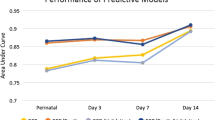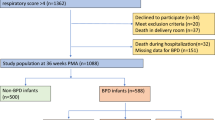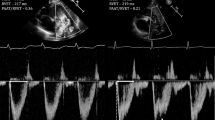Abstract
Objectives:
To identify the variables that predict death/physiologic bronchopulmonary dysplasia (BPD) in preterm infants with severe respiratory failure.
Study Design:
The study was a secondary analysis of data from the NICHD Neonatal Research Network trial of inhaled nitric oxide (iNO) in preterm infants. Stepwise logistic regression models and Classification and Regression Tree (CART) models were developed for the outcome of death or physiologic BPD (O2 at 36 weeks post-menstrual age).
Result:
Death and/or BPD was associated with lower birth weight, higher oxygen requirement, male gender, additional surfactant doses, higher oxygenation index and outborn status, but not the magnitude of response in PaO2 to iNO. The positive predictive value of the CART model was 82% at 95% sensitivity.
Conclusions:
The major factors associated with death/BPD were an increased severity of respiratory failure, lower birth weight, male gender and outborn status, but not the magnitude of initial response to iNO.
This is a preview of subscription content, access via your institution
Access options
Subscribe to this journal
Receive 12 print issues and online access
$259.00 per year
only $21.58 per issue
Buy this article
- Purchase on Springer Link
- Instant access to full article PDF
Prices may be subject to local taxes which are calculated during checkout

Similar content being viewed by others
References
Van Meurs KP, Wright LL, Ehrenkranz RA, Lemons JA, Ball MB, Poole WK et al. Inhaled nitric oxide for premature infants with severe respiratory failure. N Engl J Med 2005; 353: 13–22.
Schreiber MD, Gin-Mestan K, Marks JD, Huo D, Lee G, Srisuparp P . Inhaled nitric oxide in premature infants with the respiratory distress syndrome. N Engl J Med 2003; 349: 2099–2107.
Kinsella JP, Cutter GR, Walsh WF, Gerstmann DR, Bose CL, Hart C et al. Early inhaled nitric oxide therapy in premature newborns with respiratory failure. N Engl J Med 2006; 355: 354–364.
Ballard RA, Truog WE, Cnaan A, Martin RJ, Ballard PL, Merrill JD et al. Inhaled nitric oxide in preterm infants undergoing mechanical ventilation. N Engl J Med 2006; 355: 343–353.
Dimitriou G, Greenough A, Kavvadia V, Devane SP, Rennie JM . Outcome predictors in nitric oxide treated preterm infants. Eur J Pediatr 1999; 158: 589–591.
Walsh MC, Yao Q, Gettner P, Hale E, Collins M, Hensman A et al. Impact of a physiologic definition on bronchopulmonary dysplasia rates. Pediatrics 2004; 114: 1305–1311.
Sinkin RA, Cox C, Phelps DL . Predicting risk for bronchopulmonary dysplasia: selection criteria for clinical trials. Pediatrics 1990; 86: 728–736.
Ryan SW, Nycyk J, Shaw BN . Prediction of chronic neonatal lung disease on day 4 of life. Eur J Pediatr 1996; 155: 668–671.
Yoder BA, Anwar MU, Clark RH . Early prediction of neonatal chronic lung disease: a comparison of three scoring methods. Pediatr Pulmonol 1999; 27: 388–394.
Ambalavanan N, Carlo WA, Shankaran S, Bann CM, Emrich SL, Higgins RD et al. Predicting outcome of neonates diagnosed with hypoxemic-ischemic encephalopathy. Pediatrics 2006; 118: 2084–2093.
Germanson TP, Lanzino G, Kongable GL, Torner JC, Kassell NF . Risk classification after aneurysmal subarachnoid hemorrhage. Surg Neurol 1998; 49: 155–163.
Werneck GL, de Carvalho DM, Barroso DE, Cook EF, Walker AM . Classification trees and logistic regression applied to prognostic studies: a comparison using meningococcal disease as an example. J Trop Pediatr 1999; 45: 248–251.
Subhedar NV, Tan AT, Sweeney EM, Shaw NJ . A comparison of indices of respiratory failure in ventilated preterm infants. Arch Dis Child Fetal Neonatal Ed 2000; 83: F97–F100.
Tyson JE, Younes N, Verter J, Wright LL . Viability, morbidity, and resource use among newborns of 501- to 800-g birth weight. National Institute of Child Health and Human Development Neonatal Research Network. JAMA 1996; 276: 1645–1651.
Kumar D, Super DM, Fajardo RA, Stork EE, Moore JJ, Saker FA . Predicting outcome in neonatal hypoxic respiratory failure with the score for neonatal acute physiology (SNAP) and highest oxygen index (OI) in the first 24 h of admission. J Perinatol 2004; 24: 376–381.
Trachsel D, McCrindle BW, Nakagawa S, Bohn D . Oxygenation index predicts outcome in children with acute hypoxemic respiratory failure. Am J Respir Crit Care Med 2005; 15: 206–211.
Thome UH, Carlo WA, Pohlandt F . Ventilation strategies and outcome in randomised trials of high frequency ventilation. Arch Dis Child Fetal Neonatal Ed 2005; 90: F466–F473.
Henderson-Smart DJ, Cools F, Bhuta T, Offringa M . Elective high frequency oscillatory ventilation versus conventional ventilation for acute pulmonary dysfunction in preterm infants. Cochrane Database of Syst Rev 2007; (3): CD000104. doi: 10.1002/14651858.CD000104.pub2.
Keszler M, Donn SM, Bucciarelli RL, Alverson DC, Hart M, Lunyong V et al. Multicenter controlled trial comparing high-frequency jet ventilation and conventional mechanical ventilation in newborn infants with pulmonary interstitial emphysema. J Pediatr 1991; 119: 85–93.
Joshi VH, Bhuta T . Rescue high frequency jet ventilation versus conventional ventilation for severe pulmonary dysfunction in preterm infants. The Cochrane Database of Syst Rev 2006; 25 (1): CD000437. doi: 10.1002/14651858.CD000437.pub2.
Acknowledgements
This research was supported by grants from the National Institute of Child Health and Human Development (U10 HD34216, U10 HD27853, U10 HD27871, U10 HD40461, U10 HD40689, U10 HD27856, U10 HD27904, U10 HD40498, U10 HD40521, U01 HD36790, U10 HD21385, U10 HD27880, U10 HD27851 and U10 HD 21373) and from the General Clinical Research Centers Program (M01 RR08084, M01 RR06022, M01 RR00750, M01 RR00070, M01 RR00039 and M01 RR00044). INO Therapeutics provided study gas and support to centers that were not part of the NICHD Neonatal Research Network.
Author information
Authors and Affiliations
Consortia
Corresponding author
Appendix
Appendix
The following investigators participated in the Preemie Inhaled Nitric Oxide Study: Brown University Women & Infant's Hospital—William Oh MD, Angelita Hensman BSN RNC, Daniel Gingras RRT; Emory University—Barbara J. Stoll MD, Lucky Jain MD, Ellen Hale RN BS, Irma Seabrook BS RRT-NPS; Indiana University Riley Hospital for Children and Methodist Hospital—Greg Sokol MD, Dianne Lorant MD, Diana Dawn Appel RN BSN, Lucy Miller RN BSN, Dale Chriscinske BS RRT NPS, Jeff Attwood RRT; Northwestern University—Robin Steinhorn MD, Michael Sautel RRT; Stanford University Lucile Salter Packard Children's Hospital—Krisa Van Meurs MD, Bethany Ball BS CCRC, Dan Proud RCP; University of Alabama at Birmingham University Hospital-UAB—Waldemar A. Carlo MD, Shirley S. Cosby RN BSN, Robert B. Johnson RRT; University of Cincinnati University Hospital, Cincinnati Children's Hospital Medical Center and Good Samaritan—Jon Fridriksson MD, Barb Warner MD, Marcia Mersmann RN, Barb Alexander RN, Jody Shively RN, Holly Mincey RN, Mary Hoover RRT, Sharon Sapienz RRT, Eric Stephenson RRT; University of California-San Diego UCSD Medical Center and Sharp Mary Birch Hospital for Women—Neil N Finer MD, Maynard R Rasmussen MD, Chris Henderson CRTT, Clarence Demetrio RN, Wade Rich RRT-NPS, Christine Joseph, RRT-NPS; University of Florida Wolfson Children's Hospital at Baptist Medical Center and Shands Jacksonville Medical Center—Mark Hudak MD, Shannon Osbeck RN BSN, Elizabeth Case RN BSN CCRC, Amanda Kellum RRT, Lamont Hogans RRT; University of Rochester Golisano Children's Hospital at Strong—Carl T D'Angio MD, Linda Reubens RN, Greg Hutton RRT; University of Texas—Dallas Parkland—Abbot Laptook MD; Susie Madison RN, Gay Hensley RN, Nancy Miller RN, Glenn Metoyer RRT; University of Texas—Houston Memorial Hermann Children's Hospital—Kathleen Kennedy MD MPH, Georgia McDavid RN, Danny Emerson RRT RCP; Medical College of Wisconsin—Ganesh Konduri MD, Mike Paquette RCP/CRT, Steven Wong RCP/CRT; Wake Forest University Wake Forest University Baptist Medical Center, Forsyth Medical Center and Brenner Children's Hospital—Judy Aschner MD, T Michael O'Shea MD MPH, Nancy Peters RN, BJ Hansell RRT CCRC, Jennifer Griffin RRT RCP, Clay Adams RRT RCP; Wayne State University Hutzel Women's Hospital & Children's Hospital of Michigan—Seetha Shankaran MD, Rebecca Bara RN BSN, Geraldine Muran RN BSN, Wonder Weekfall RRT; Yale University New Haven Children's Hospital Richard A Ehrenkranz MD, Patricia Gettner RN, Art Caldwell AS RRT.
The members of the National Institute of Child Health and Human Development Neonatal Research Steering Committee were: Brown University—William Oh MD, Case Western University—Avroy A Fanaroff MD, Duke University—Ronald N Goldberg MD, Emory University—Barbara J Stoll MD, Indiana University—James A Lemons MD, Stanford University—David K Stevenson MD, University of Alabama at Birmingham—Waldemar A Carlo MD, University of Cincinnati—Edward F Donovan MD, University of California-San Diego—Neil N Finer MD, University of Miami—Shahnaz Duara MD, University of Rochester—Dale L Phelps MD, University of Texas- Dallas—Abbot R Laptook MD, University of Texas—Houston—Jon E Tyson MD MPH, Wake Forest University—T Michael O'Shea MD MPH, Wayne State University—Seetha Shankaran MD, Yale University—Richard A Ehrenkranz MD, University of Cincinnati—Alan Jobe MD (Chair).
The members of the Data Coordinating Center (RTI International) were: W Kenneth Poole PhD, Betty Hastings, Carolyn Petrie MS.
The members of National Institute of Child Health and Human Development were: Rosemary D Higgins MD, Linda L Wright MD, Elizabeth McClure MEd.
Rights and permissions
About this article
Cite this article
Ambalavanan, N., Van Meurs, K., Perritt, R. et al. Predictors of death or bronchopulmonary dysplasia in preterm infants with respiratory failure. J Perinatol 28, 420–426 (2008). https://doi.org/10.1038/jp.2008.18
Received:
Revised:
Accepted:
Published:
Issue Date:
DOI: https://doi.org/10.1038/jp.2008.18
Keywords
This article is cited by
-
Human milk exosome-derived circDNAJB6 improves bronchopulmonary dysplasia model by promoting DNAJB6 gene transcription
Journal of Bioenergetics and Biomembranes (2024)
-
Increased mitochondrial oxygen consumption in adult survivors of preterm birth
Pediatric Research (2021)
-
New BPD-prevalence and risk factors for bronchopulmonary dysplasia/mortality in extremely low gestational age infants ≤28 weeks
Journal of Perinatology (2021)
-
Adjustment of high flow nasal cannula rates using real-time work of breathing indices in premature infants with respiratory insufficiency
Journal of Perinatology (2021)
-
Recent Advances in Bronchopulmonary Dysplasia
Indian Journal of Pediatrics (2021)



